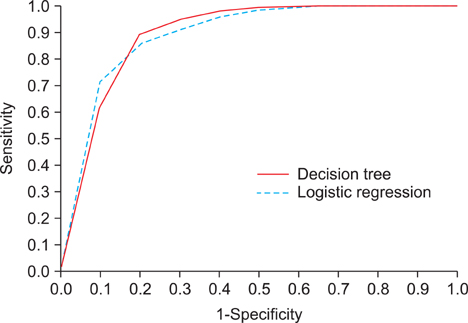Healthc Inform Res.
2012 Sep;18(3):178-185. 10.4258/hir.2012.18.3.178.
Data Mining Application in Customer Relationship Management for Hospital Inpatients
- Affiliations
-
- 1Department of Social and Preventive Medicine, Sungkyunkwan University School of Medicine, Suwon, Korea. ewlee@skku.edu
- KMID: 2229468
- DOI: http://doi.org/10.4258/hir.2012.18.3.178
Abstract
OBJECTIVES
This study aims to discover patients loyal to a hospital and model their medical service usage patterns. Consequently, this study proposes a data mining application in customer relationship management (CRM) for hospital inpatients.
METHODS
A recency, frequency, monetary (RFM) model has been applied toward 14,072 patients discharged from a university hospital. Cluster analysis was conducted to segment customers, and it modeled the patterns of the loyal customers' medical services usage via a decision tree.
RESULTS
Patients were divided into two groups according to the variables of the RFM model and the group which had significantly high frequency of medical use and expenses was defined as loyal customers, a target market. As a result of the decision tree, the predictable factors of the loyal clients were; length of stay, certainty of selectable treatment, surgery, number of accompanying treatments, kind of patient room, and department from which they were discharged. Particularly, this research showed that when a patient within the internal medicine department who did not have surgery stayed for more than 13.5 days, their probability of being a classified as a loyal customer was 70.0%.
CONCLUSIONS
To discover a hospital's loyal patients and model their medical usage patterns, the application of data-mining has been suggested. This paper suggests practical use of combining segmentation, targeting, positioning (STP) strategy and the RFM model with data-mining in CRM.
Keyword
MeSH Terms
Figure
Reference
-
1. Hwang SW, Lee HJ. Development of a revisit prediction model for the outpatient in a hospital. J Korean Soc Med Inform. 2008. 14(2):137–145.
Article2. Powell J, Clarke A. The WWW of the World Wide Web: who, what, and why? J Med Internet Res. 2002. 4(1):e4.
Article3. Coile RC Jr. Competing in a "consumer choice" market. J Healthc Manag. 2001. 46(5):297–300.
Article4. Scott G. Customer satisfaction: six strategies for continuous improvement. J Healthc Manag. 2001. 46(2):82–85.
Article5. Tiwana A. The essential guide to knowledge management: e-business and CRM applications. 2001. Upper Saddle River: Prentice Hall;23–30.6. Reichheld FF, Sasser WE Jr. Zero defections: quality comes to services. Harv Bus Rev. 1990. 68(5):105–111.7. Young T. Hospital CRM: unexplored frontier of revenue growth? Healthc Financ Manage. 2007. 61(10):86–90.8. Bose R. Customer relationship management: key components for IT success. Ind Manag Data Syst. 2002. 102(2):89–97.
Article9. Kotler P, Keller KL. Marketing management. 2011. Harlow, UK: Pearson Education.10. Weber A. A simple way to use RFM. Targ Mark. 1997. 20(3):72–75.11. Chen YL, Kuo MH, Wu SY, Tang K. Discovering recency, frequency, and monetary (RFM) sequential patterns from customers' purchasing data. Electron Commer Res Appl. 2009. 8(5):241–251.
Article12. Wei JT, Lin SY, Weng CC, Wu HH. A case study of applying LRFM model in market segmentation of a children's dental clinic. Expert Syst Appl. 2012. 39(5):5529–5533.
Article13. Han J, Kamber M. Data mining: concepts and techniques. 2006. 2nd ed. Amsterdam: Morgan Kaufmann.14. Giudici P, Figini S. Applied data mining for business and industry. 2009. 2nd ed. Chichester, UK: Wiley.15. Bellazzi R, Zupan B. Predictive data mining in clinical medicine: current issues and guidelines. Int J Med Inform. 2008. 77(2):81–97.
Article16. Steyerberg EW, Borsboom GJ, van Houwelingen HC, Eijkemans MJ, Habbema JD. Validation and updating of predictive logistic regression models: a study on sample size and shrinkage. Stat Med. 2004. 23(16):2567–2586.
Article17. Kang JO, Chung SH, Suh YM. Prediction of hospital charges for the cancer patients with data mining techniques. J Korean Soc Med Inform. 2009. 15(1):13–23.
Article18. Kim ON, Kim YH, Kang SH, Kim SH. A study on effects of critical pathway practices by using BSC and datamining method. J Korean Soc Med Inform. 2002. 8(2):51–68.
Article19. Lee EW. Selecting the best prediction model for readmission. J Prev Med Public Health. 2012. 45(4):259–266.
Article
- Full Text Links
- Actions
-
Cited
- CITED
-
- Close
- Share
- Similar articles
-
- Development of Customer Relationship Management System in the Healthcare Domain Using Data Mining
- The Causality among the Internal Customer Satisfaction, the External Customer Satisfaction and the Customer Loyalty of Medical Service
- Hospital Database Marketing Using Discharge Summary DB: An Application of Data Mining Technique
- Development of a revisit prediction model for the outpatient in a hospital
- A Study on Service Quality and Customer Loyalty of Foodservice Industry



